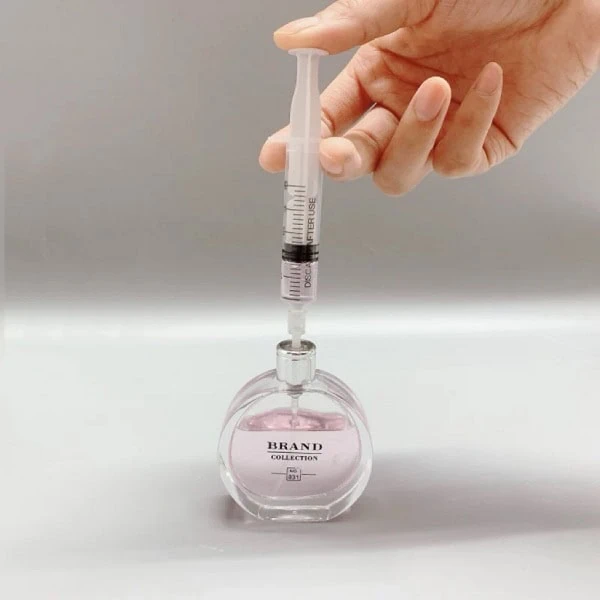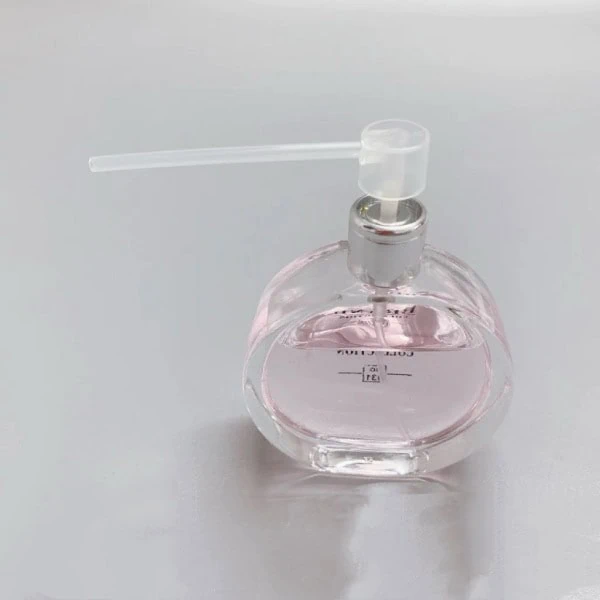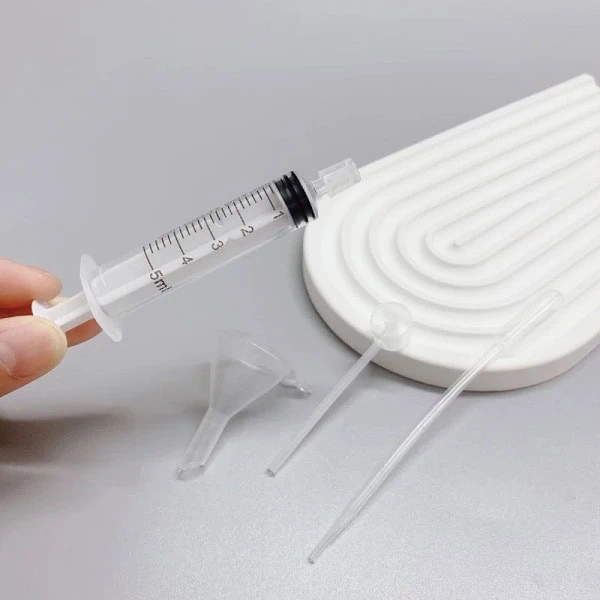Perfume lovers know the struggle: you want to transfer your fragrance, but you’re afraid of spilling a single precious drop. The right tool can make all the difference, but which one is better for decanting without any waste?
Decanting perfume with a syringe or a funnel both have pros and cons, but a syringe is usually the best option. Syringes offer more precision and control, which reduces the risk of spills and waste. Funnels are less precise and can lead to messy transfers and lost fragrance, especially with smaller bottles.

When I first started in the glass bottle business, I saw many different uses for small bottles, but decanting perfume was one of the most common. People were always looking for the best way to move their favorite scents from a large bottle to a smaller one. It seemed like everyone had a favorite method, but I always preferred the most precise tools. After all, every drop of a quality fragrance is valuable.
How to Decant Perfume Without a Syringe?
Are you wondering how to transfer your perfume without using a syringe, maybe because you don’t have one? Many people think a syringe is the only way to get a clean transfer, but there are other methods that work just as well.
To decant perfume without a syringe, you can use a small funnel, a pour-over method, or a transfer pump. A small funnel is the most common alternative, but it requires a steady hand to avoid spills. The pour-over method involves carefully pouring from the original bottle to the new one, but this can be messy. A perfume transfer pump is a good choice for a clean transfer.

When a customer asked me about this, I remembered a time I needed to transfer a fragrance but couldn’t find my syringe. I had to improvise. The pour-over method was a disaster; I lost so much of the liquid. The funnel worked better, but it was still a bit messy. This experience taught me that while other methods exist, a syringe is often the best choice for a truly clean transfer.
The Pour-Over Method
This method is the most basic. You just pour the perfume from the original bottle into the smaller bottle. This is very difficult to do without spilling. It is best for bottles with a wide opening. You should always do this over a tray.
- Pros: No special tools needed. Very simple to understand.
- Cons: Very high chance of spilling. A lot of perfume can be wasted.
- Best for: When you have a wide mouth bottle and you have no other choice.
| Pour-Over Method | Best For | Worst For |
|---|---|---|
| Wide Mouth Bottles | Yes | No |
| Small Travel Atomizers | No | Yes |
| Thick Liquids | Yes | No |
| Precision | No | Yes |
How to Properly Decant a Perfume?
Are you struggling to get a clean transfer without losing any of your perfume? Decanting perfume correctly is about more than just the tool you use; it is about the technique.
The proper way to decant a perfume involves using a clean, dry transfer tool like a syringe or a funnel, and working on a stable, flat surface. You should always move slowly and carefully to avoid spills. Make sure your destination bottle is also clean. By following these steps, you can get the best possible transfer and avoid any waste.

In my experience helping clients with their packaging, I have learned that the process is just as important as the product. The same is true for decanting perfume. I once saw a client try to rush a transfer, and they ended up losing half the liquid. I told him to slow down and use the right technique. He was surprised by how much better the results were.
Step-by-Step Guide for Perfect Decanting
This guide will help you get a perfect transfer every time. The most important thing is to be patient. You cannot rush this process.
- Prepare your workspace: Lay down a clean towel or paper on a flat table. This will catch any small drips.
- Clean your tools: Make sure your syringe or funnel is completely clean and dry. Any water or dust can ruin the perfume.
- Remove the sprayer: Gently pull off the cap and the sprayer head from the original bottle.
- Insert the tool: Put the tip of the syringe or the funnel into the new bottle.
- Transfer slowly: Pump the syringe slowly or pour the perfume very gently through the funnel.
- Clean up: Replace the sprayer head. Clean any drips on the bottles.
| Step | Why It’s Important | What Can Go Wrong |
|---|---|---|
| Prepare | Catches spills and protects the surface. | You could ruin your table or lose perfume. |
| Clean Tools | Prevents contamination of the perfume. | The perfume’s smell could change. |
| Remove Sprayer | Gives you a direct opening to the perfume. | You could break the bottle if you are too rough. |
| Insert Tool | Ensures the perfume goes into the new bottle. | If you don’t do this, you will spill the perfume. |
| Transfer Slowly | Gives you control and prevents waste. | You could cause a splash and lose liquid. |
| Clean Up | Keeps your bottles looking nice. | Your bottle can feel sticky. |
Can I Use a Syringe for Perfume?
Are you wondering if a syringe is the right tool for handling perfume? Many people ask this question because they are not sure if the material is safe or if it will work.
Yes, you can use a syringe for perfume. A syringe is one of the best tools for decanting perfume because it gives you excellent control and precision. This helps you avoid spills and waste. You should use a new, clean syringe for each different perfume to prevent mixing scents. The syringe material is usually safe and will not change the perfume’s smell.

I have seen many people use syringes to fill perfume bottles. I know this is a common practice in the industry. It is a very effective way to get the exact amount of liquid you need into a small bottle. I even use this method myself when I test new glass vials. It is the most reliable way to fill small containers without a mess.
The Benefits of Using a Syringe
Using a syringe has many benefits over other methods. It is the most professional way to transfer liquid. It gives you great control.
- Precision: You can measure the exact amount of liquid you want to transfer. This is great for making samples.
- No Waste: The small needle lets you get into tight spaces. This means less liquid is left behind or spilled.
- Cleanliness: Syringes are easy to clean. You can rinse them and let them dry for the next use.
- Versatility: You can use them for many different types of liquids, not just perfume.
| Syringe Benefit | How It Helps |
|---|---|
| Precision Control | Allows you to transfer small amounts without spilling. |
| Reduced Waste | Prevents perfume from being left behind in the bottle. |
| Cleanliness | The syringe can be cleaned and reused for different perfumes. |
| Ease of Use | You can fill small sample bottles and atomizers easily. |
How to Refill Perfume Without a Funnel?
Are you trying to refill your perfume and you don’t have a funnel? Many people run into this problem, but there are other ways to get the job done.
To refill perfume without a funnel, you can use a small syringe or a pour-over method with a steady hand. A syringe is the best alternative because it gives you precision and control, which reduces the risk of spills. The pour-over method can be used in an emergency, but it often leads to a lot of wasted product and a mess. Using a transfer pump is also an option for a no-mess refill.

A customer once told me they had tried to refill a bottle without a funnel and ended up with perfume everywhere. I told them about the different methods, especially the syringe. They were worried it would be too hard to use, but they were very happy with the results. It is the best way to get a clean transfer.
Alternatives to Funnels
There are several options you can use if you do not have a funnel. Some of these are better than others. You need to pick the right method for your situation.
- Syringe: This is the best choice. It gives you total control over the flow of liquid. You can get the perfume exactly where you want it to go.
- Pour-Over Method: This is the most basic way. You pour the perfume directly from the big bottle into the small one. This is very hard to do without spills.
- Perfume Transfer Pump: These are small tools made specifically for this job. They work well, but you have to buy them. They are very simple to use.
| Alternative | Pros | Cons |
|---|---|---|
| Syringe | Very precise, no waste, easy to control. | You have to have one ready. |
| Pour-Over | No tools needed, very simple. | High chance of spills, a lot of waste. |
| Transfer Pump | Made for this, very clean. | You have to buy the tool. |
Conclusion
Both syringes and funnels have their place in decanting perfume, but a syringe is the superior tool for precision and waste reduction. A proper technique is also key to a clean transfer, no matter the tool.

